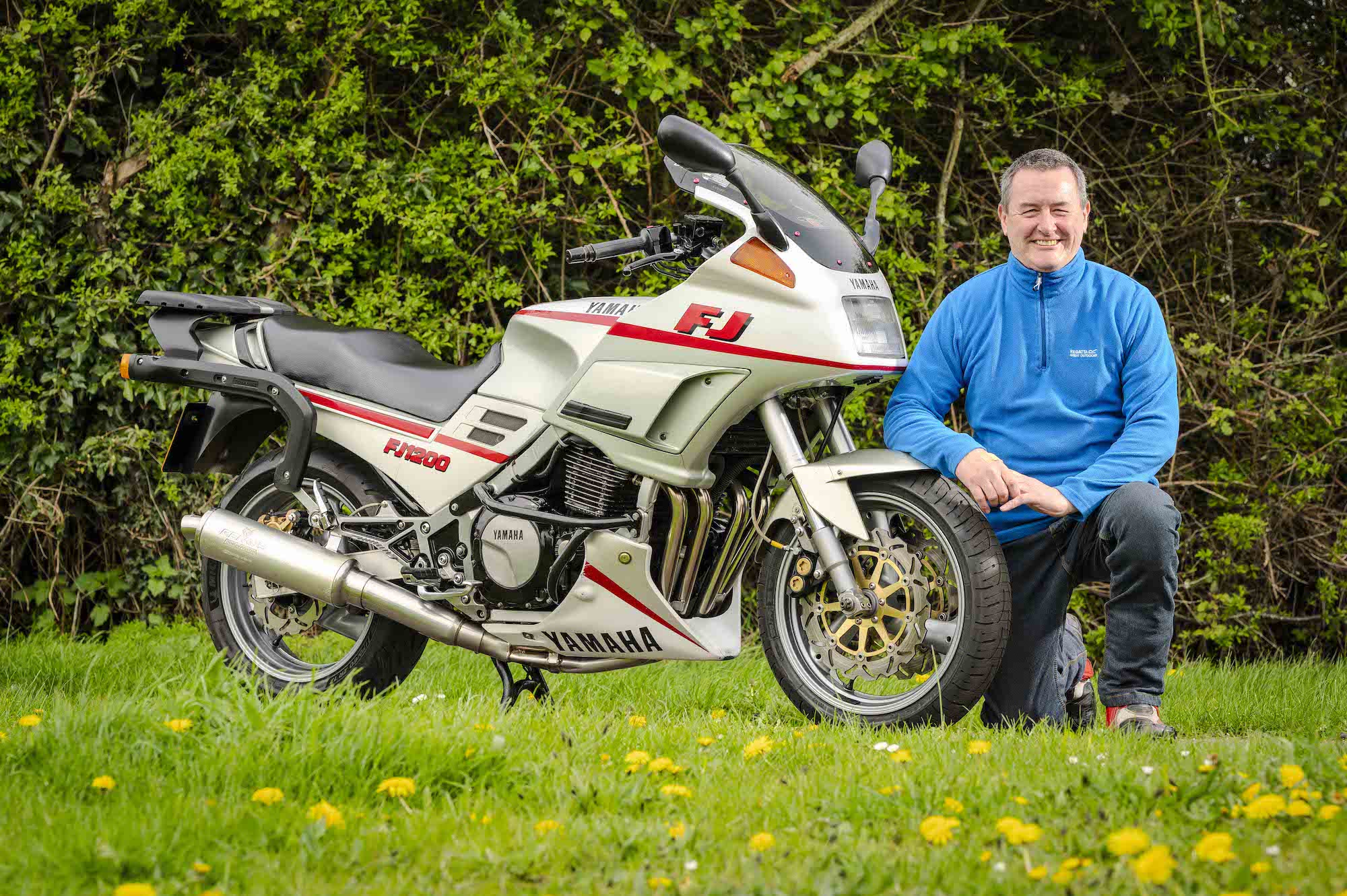When Keith bought his Vincent HRD 500 Comet as a basket case in 1992, he had no idea of the bike’s history.
It was only after Ian Savage of the Vincent HRD Owners Club (VOC) came to look at the Comet at Keith’s home that he realised what he had on his hands.
“He looked at the engine and frame numbers, which matched, and said it was a really, really low number,” he says. “In fact, it was the lowest number of all, and then we investigated. Although the prototype was made with a first batch of six bikes, my bike was one number below the prototype.”
Closer inspection revealed the number ‘2’ stamped on the crankcase – it’s not known if there was a ‘1’ – and then it came to light that the Comet was used as the display bike at the Earls Court show.
Built in early 1949, Keith’s bike is one of only two of the original six Series C Comets made. The other is number ‘5’.
At the time, Vincent was known for the 1,000cc V-twin Black Shadow, the fastest production bike on the planet.
The 500cc Comet and Meteor – effectively half a Black Shadow – were introduced to gain a larger market share, but they weren’t exactly cheap.
Pricey Comet
At £273, the Comet was the most expensive single-cylinder production bike in the world.
All of which helps explain why, when he was looking to get back into biking in 1992 after a 25-year break, a Vincent was at the top of Keith’s shopping list.
His first motorbike was a Ducati 175, bought at the age of 17 in 1964, but he was already acquainted with bikes through his father.
“Dad had an old Norton with a massive sidecar that the whole family would go out in,” he remembers. “The Ducati was a nice bike that I used to ride to work repairing cameras at RF Hunter.
“After that I bought a BSA Road Rocket with a sidecar and that was good fun to ride.”
But marriage and a car at 21 put a halt to his life on two wheels until, at 45 and now with his second wife, he got the itch again.
“It was probably a midlife crisis,” he laughs, “and the Vincent was always the bike that everybody wanted. I started looking through the magazines at what was available.
“I saw one that had been in bits for 20 years advertised for £2,500 – which was quite a lot of money back then.”
Basketcase
The advert made no bones about its condition, describing it as a “basketcase”, and it really was.
“He was selling it for his grandma,” says Keith. “His grandad had died and he’d taken it apart 20 years earlier to overhaul it, and it had stayed in a shed in bits all that time.”
Before setting off to go and look at the Vincent, Keith got in touch with Savage of the VOC.
“I asked him ‘what bits are not available? What bits have got to be there?’, because that hinged on whether I was going to buy it or not,” he says. “There were quite a few things that had to be there, and luckily they were.”
Even so, when he got the dismantled Comet back to his garage on February 10, 1992, he could be forgiven for having second thoughts.
“There were all these rusty bits, and I thought ‘oh my God, what have I done?’” says Keith, now 77.
“But Ian came down and confirmed everything was there, and that it was all original parts. He said ‘you’ve done all right’. Because it was a show bike, they put non standard dome nuts on it to posh it up a bit, and they were with it too. I’ve had them nickel plated.”
Over 18 months to two years, Keith worked evenings and weekends to rebuild the Vincent virtually from scratch, refurbishing parts where he could, or using remanufactured parts from the VOC when something was too far gone to be rescued.
Rebuilt from scratch
“I wanted to rebuild it exactly as it was,” he says, “so where I could I would use the original part rather than get a replacement.”
His task was aided by an original Vincent HRD parts book with exploded views of the bikes.
“It was amazingly useful, because it tells you what size nuts you need, where everything goes and how it fits together,” adds Keith, who had plenty of practice in his younger days repairing his Road Rocket, which was “always breaking down”.
Among the replacement parts sourced from the VOC were rivets, copper washers and bolts, brake linings, silencer, exhaust system, tank mount, and seat.
The original headlamp and fuel tank were refurbished, while the wheel rims, which arrived without spokes, were restored and respoked. Frame and fuel tank were also resprayed.
The engine was a major undertaking, with new big end bearings, small end bearings, bushes, piston, and barrel, and the big end and flywheel sent away for refurbishment.
It also nearly caused a major domestic incident…
“In order to get the bearings out, you have to heat the crankcase up to 200C and then the bearings will fall out,” says Keith. “I cleaned it up, put it in the oven and went back outside. After half an hour I came back in and the kitchen was full of smoke. I could hardly see across the room.
“I had to open all the doors and windows before my wife Marilyn came back or she’d do her nut, which is what happened because you could still smell it.
“The problem was I couldn’t get behind the bearings to clean all the oil out. I had to heat it up again to put the bearings back in, but by then it was clean because I’d bead blasted it.”
One of the first
As one of the first Comets manufactured, Keith’s bike has a few differences to the later full production run.
“They are all little things, but when they went into production they didn’t bother with a lot of them,” he says. “For example, on the end of the swinging arm there’s a thread, and the idea was to have a point for attaching a sidecar. But it’s right at the end of the swinging arm and it must have caused more problems than it was worth, so they didn’t bother with it.
“They also had four bolts holding the battery on, but they quickly realised they only needed two.”
The company, which wasn’t flush with cash, also used whatever parts they could their hands on for those first six bikes.
“This has the headlight off a Series B,” says Keith, “but it has the correct ‘Girdraulic’ forks of the Series C.
“It also has the wrong head on it – the rear head from the V-twin whereas it should be the front head.
“People used to pinch the front head from the singles and put two front heads on the V-twin, because they reckoned the front head was better. I always reckoned mine had been pinched, but when I spoke to the archivist at Vincent he said mine was manufactured like that.”
Keith reckons he spent between £2,000 and £3,000 on the rebuild, and the old bike started without too much trouble at the end of it.
Cautious Keith
After nearly three decades out of the saddle, he was understandably cautious when he ventured out for the first time.
“I was shit scared, I suppose,” he laughs, “because I’d spent all this money and all this effort, and the last thing I wanted to do was drop it. I’d never ridden a bike that heavy – the Road Rocket was a combination, so it is a bit different.
“It takes a little while to get back into riding again, being confident to lean over and stuff, so I asked a friend of mine, who was a caretaker at the school down the road, if I could ride around the car park for half an hour or so when the kids aren’t there.
“I did that, just to get the feel of it, and that was all right so then I took it out on the road and started riding properly. It’s a very forgiving bike.”
With Marilyn an uneasy passenger, Keith mostly used the bike for local runs, although he did go as far as Brands Hatch after joining the Classic Racing Motorcycle Club.
“I bought a Triton at the time and wanted to put it on the track, but sadly never did,” he says.
“Marilyn and I used to do everything together, but she was never really one for going on the back. I didn’t really like going off for the day with mates on the bikes, so it was mostly used locally just for my pleasure.
“She did come on the back sometimes – but we’d go round a corner, I’d be leaning over and she’d be sitting up again so she’s pulling it up, not ideal!”
Seafront cruise
With Southend not too far away, the couple did the obligatory seafront cruise together, and attended a few shows.
“We did one in Harlow, which was a VOC meeting with 50 or 60 Comets all lined up in a row,” he remembers. “It was brilliant.”
Unfortunately, Keith has been unable to ride for the past couple of years because of hip problems and subsequent hip replacement surgery.
“I could get on it, but I couldn’t get off without help, which was not very good if you’re going somewhere,” he says. “And I swear the bike is putting on weight – it feels a lot heavier than it used to be.
“I go to the gym three times a week because you lose muscle mass, but obviously you get weaker as you get older.”
Keith’s other hip may well need surgery in the next year or so, leaving him with a decision to make about the Vincent.
“I’m loath to get rid of it really,” he says. “It means a lot to me, like an old friend really. It would be a wrench to sell it, but I just don’t want it to become a rust heap again. I’m very fond of the old thing.
“It needs to be ridden – the worst thing you can do is just leave it doing nothing.”
So this historic bike, first sold to Jack Surtees in South London in late 1949, could be moving on to its next adventure.























